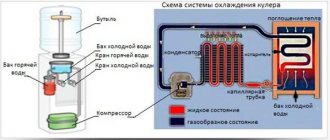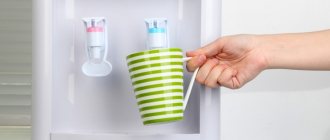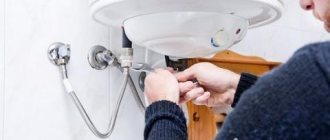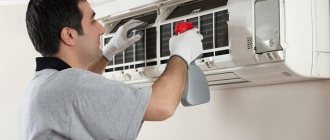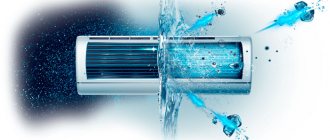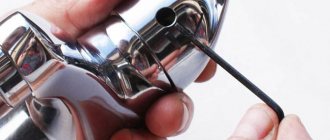Water is the source of life for almost every living organism on Earth, which is why it is so important to drink the established amount of clean liquid in order to maintain the necessary balance and health. Nowadays, we can note a craze for proper nutrition and proper care of one’s own body. Many people have stopped drinking low-quality water from the water supply; a healthy alternative is purified water from the cooler. However, few people think about how often it is necessary to clean the water cooler, because the purity of the liquid and the health of its consumer primarily depend on this.
This device is necessary not only for commercial enterprises, but also for residential premises, rooms, houses, apartments. The desire to buy a cooler is completely justified, because it is better to drink good and safe water from the manufacturer than to risk your own health and drink questionable liquid from the water supply system.
Why clean the cooler?
When used, the internal elements of the device are gradually contaminated, plaque appears, which ultimately affects the taste of the water and human well-being. Moreover, such an environment is fertile for the development of a variety of microorganisms and bacteria that lead to diseases. Cooler sanitation is necessary to keep the water clean. If this problem is not solved in time, it can lead to serious consequences: deterioration of health, poisoning. To begin with, we list the main factors that affect water pollution and increase the likelihood of developing diseases:
- Bacteria that thrive in a favorable environment (warm water) can penetrate into the device, which forms a harmful coating on individual components and elements of the device.
- One of the main functions of the cooler is to heat the water, so over time, scale forms on the surface of the heating device, which reduces the level of purity of the water.
- Bacteria may appear on the external elements of the device due to contact with people: germs on the tap, buttons, front panel, drip trays. After some time, harmful microorganisms enter the human body.
- Water purification is a complex process that requires special equipment, so not all suppliers take their responsibilities responsibly. Algae spores can get into the water, then the liquid begins to bloom and is harmful to health. Next, plant organisms settle on the inner surface of the entire system.
Why is it so important to clean the cooler?
If a brownish hard deposit is noticeable in the bottle receptacle, then the same thing is in the hot water tank, which you will not be able to examine yourself. The presence of such deposits can lead to burnout of the heating element, the part of the tank that is responsible for heating the water.
“As long as it works, if it burns out, we’ll replace it,” someone might say so. Let us answer: not in all cooler models it is possible to change only the heating element. In some cases, you will have to change it along with the hot water tank. And this will cost much more than just sanitary treatment.
The water bottle is not tightly connected to the cooler, which means that various bacteria get into the water tank, where they begin to multiply. What will happen next - you yourself can guess.
If the cooler was left without using water after a long period of storage, then most likely there was minimal stagnation of water inside. A family of microbes has already settled in this favorable environment, so it is urgent to sanitize the cooler.
Therefore, sanitary treatment is necessary:
- to clean the heating element from scale;
- for cleaning the elastic parts of the sealing elements of the dispenser (valves, gaskets) from settling salts;
- for disinfection of internal tanks, taps for water distribution, pipes.
How often to clean your device
This question worries many users of these devices. The device must be cleaned even after changing the water supplier. If the device has not been used for a long time, it is necessary to contact specialists to carry out sanitary work. When the cooler operates around the clock, the internal components should be treated regularly. In turn, manufacturers advise washing the internal structure at least once every six months. Many users note that it is better to carry out sanitary work every three months, in which case it is possible to reduce the likelihood of bacterial growth and health hazards.
If you plan to do the cleaning yourself, you may encounter certain difficulties. Before disassembling the device, you should unplug it from the outlet and allow time for the system to cool down.
conclusions
- To keep your water clean and your equipment working, carry out preventative cleaning of the cooler once every 3-6 months on your own or with the help of specialists. Also, do not forget to wash the faucets, drip tray, front panel, and of course, wipe the entire cooler body yourself at least once every 2 weeks. This procedure is simple, but very useful.
- When installing the bottle on the cooler, be sure to remove the protective thermal cap on the cap and the protective sticker on top of the cap. If the bottle does not have a thermal cap, disinfect the cap so as not to introduce bacteria into the cooler and not to drink spoiled water.
- To reduce scale on electrical appliances, use deeply purified drinking bottled water. This will help protect your equipment from damage by salt deposits. Remember that it is healthier to drink mineral water unboiled.
These simple rules will help you drink only clean and healthy water.
www.magicwaters.ru
Recommendations for cleansing and some contraindications
Professionals advise sanitizing the cooler once after thirty days of operation, despite the fact that the manufacturer’s recommendations indicate a completely different period (six months). However, we all wash dishes after each use, so why does such an important device for maintaining clean water need to be washed after such a long period of time? It is enough to disassemble the device to see for yourself that sanitary work has been needed for a long time. You will be able to find not only scale, but also green vegetation on the internal nodes. Regular flushing will significantly increase the purity of the fluid and increase the operating time of the equipment.
Before you learn how to clean a water cooler, you should learn some of the nuances of the work that will allow you to avoid the most common mistakes. There is no need to wash machine parts under running tap water, as such actions will not bring the desired result, because it is best not to think about the quality and purity of such a liquid. Steam cleaning devices and dishwashers are also not suitable for solving this problem.
What you need for cleaning
Before you begin the procedure, you need to carefully study its intricacies. Do not clean the inside of the device under a tap with running water. Experts also strongly discourage the use of steam cleaners or dishwashers.
Important information! The use of powders, abrasive substances and flammable liquids: acetone, kerosene or gasoline is strictly prohibited. They destroy parts of the device and can lead to failure.
Cleaning can be timed to coincide with changing the bottle. It is better to prepare in advance the products that will be useful in order to wash the cooler:
- gel, cream or liquid dishwashing detergent;
- brush;
- dishes with clean water (basin or bowl);
- rubber household gloves;
- paper napkins or towels;
- a solution of 5 liters of water and 1/3 cup of citric acid.
Detailed cleaning instructions
There are several basic methods for cleaning a cooler; we list the main stages of sanitary work. This method is perfect in a situation where the water has not yet been heavily polluted. Cleaning a water cooler at home is quite simple; you just need to fulfill a few conditions. The most convenient time for professional cleansing is when the liquid runs out. Next, you need to turn off the device and give it time to cool down so as not to get burned when cleaning. Remember that you cannot turn on the device again while you are doing maintenance, otherwise you may damage the heater. Cleaning a water cooler yourself is easy and won't make you sweat at all, you just need to follow the instructions.
Preparatory work
You need to open up the product you usually use to clean dishes and mix it with water to clean the body of the appliance. It would also be a good idea to purchase citric acid; it will cope well with microorganisms and “centuries-old” plaque.
External surface cleaning
Disinfect your hands with an antiseptic, which can be alcohol, good soap, or simply wear medical gloves. Wipe the surface of the machine thoroughly with a damp cloth; it can be pre-soaked in dishwashing solution. Pay special attention to the grille and the back of the device, you need to remove all traces of dust. After this, you should go over the body again with a dry towel. External washing is of great importance, as it eliminates bacteria that subsequently enter the machine.
How to wash the inside
To do this, use a prepared mixture of citric acid and water in a ratio of 100 g of product per 5 liters of liquid. If you are wondering: how to clean a fan? – then there is nothing complicated, you need to thoroughly wipe it from dust. Next you need to disassemble and clean the cooler.
Cleaning, disinfection
To perform internal disinfection, unscrew the bottle receptacle counterclockwise. Pour the diluted mixture inside the device so that it fills the receiving tank. Be careful: the liquid must completely fill the tank. To do this, you need to open the taps and monitor the thickness of the jet, which should be the same as during normal operation of the cooler. If the water flow is weak, then you need to add detergent to the tank.
Scale
The method described above, that is, a solution of citric acid, will not only destroy bacteria and algae, but also rid the device of scale. To effectively remove the deposits that have formed, you should plug the device into a power outlet and wait until the water heats up. Then turn off the cooler and drain the water after five hours. How to wash the device? Quite simple: pour clean water and repeat heating, release the first batch and enjoy using it.
If you haven’t washed the cooler for a long time and the water coming from the taps is very dirty, then the cleaning process becomes much more complicated. In this case, it is necessary to use special chemicals that can be found in specialized retail outlets.
Cleaning removable parts
After you have managed to wash the device from the inside, you should move on to cleaning the removable parts. Remove the drip tray and taps and rinse them thoroughly. Don't be afraid to use a brush and dishwashing chemicals. After the procedure, you should wipe these elements dry and put the parts back in place. If you find it difficult to remember the location of the devices, make a note with a marker.
Rinsing
Rinse the container and equipment from the mixture or special compositions purchased in the store and intended for cleaning, fill with clean water. If you feel a sour taste, you need to repeat the procedure several more times.
The dangers of drinking water from an unclean cooler
You may also be interested in: Where to complain if your water quality is poor
You may be wondering whether you need to clean your water cooler at all. If the dispenser is not cleaned in a timely manner, its walls will gradually become overgrown with microscopic algae. This process is called biological fouling. Algae produce toxic substances that enter the water and poison it. If a person consumes such liquid, at best, an upset stomach will follow, and at worst, infection with salmonellosis, shigellosis and other unpleasant diseases.
During periodic examinations of water from dispensers, laboratory specialists often detect pathogens such as salmonella, E. coli, as well as pseudomonas, hepatitis A viruses and other dangerous bacteria.
By the way! The Germans have long abandoned the use of water coolers at home and in offices. These devices were prohibited by law after the water was tested by the sanitary service. The samples were taken from thousands of dispensers installed in typical office buildings. It turned out that every third sample contained dangerous bacteria and microorganisms. That is, every third device contained contaminated water. Do you now think it is necessary to clean the water cooler?
In Russia, on the contrary, dispensers, as affordable installations for bottling “clean” water, are gaining popularity every year. Many people believe that water from a cooler is safer and healthier than water from a tap. How are things going in reality?
Companies that supply purified water are required to have all the documentation guaranteeing the purity and quality of the products, and certificates of compliance with SanPin standards. In addition, the company must have information about the chemical and biological composition of water, and the supply contract must also indicate its quality category - first or highest.
Water should be tested regularly in laboratory conditions. In addition, it is necessary to periodically check water taken directly from the cooler, especially if there are suspicions about its quality.
Of course, the number of people who use the dispenser is also important. Representatives of the Federal Service for Surveillance on Consumer Rights Protection and Human Welfare and sanitary services of large cities across the country report disappointing facts - almost all water samples taken in office coolers, based on laboratory tests, do not meet accepted standards.
For example, there is a small amount of salts with an overestimated presence of organic substances. Moreover, there are more and more companies supplying bottled water every year, and the quality of the water is getting lower.
Therefore, in order not to drink low-quality water from the cooler, you need to:
- Study in detail the supplier’s documents for water, namely available quality certificates, laboratory reports, etc.
- Understand how to properly clean a water cooler and take good care of it, keeping it clean and tidy.
What actions to take if the water in the cooler has bloomed?
In this case, you need to take the following actions:
- Disassemble the device.
- Carefully treat all internal elements with cooler cleaning products.
- It would also be a good idea to disinfect the bottle and liquid supply system.
- Thoroughly wash all removable elements with a brush.
- Fill with fresh water and attach all parts. Wear medical gloves.
Cleaning the cooler yourself
Thorough treatment of one cooler to remove germs and scale takes 2 hours. In addition to your free time, you will need a set of cleaning products, the obligatory skill of disassembling such devices and a bit of patience. To learn how to clean your water cooler yourself, read our guide to washing and sanitizing your water cooler.
All the worries and difficulties of this procedure can be placed on the shoulders of specialists. This service is in great demand and there are many companies that provide professional maintenance and sanitation of water coolers. We will tell you more about this service below.
When is professional cleaning necessary?
If the water coming from the tap has bloomed, then it is better to contact highly qualified employees who will perform all the necessary work to clean the cooler. Such companies use modern equipment and high-quality cleaning products. After receiving the device, wash its outer casing and pour a liter of water.
How to clean?
After disconnecting the device from the mains, you need to wipe all external surfaces using a damp sponge. For internal cleaning, you must first remove the bottle and then drain the remaining water. Many models have special holes through which complete drainage is carried out. After this, you need to remove the plug and get rid of the remaining liquid.
To avoid getting burned by boiling water, after turning off the cooler, you should wait a few minutes until the device cools down completely.
For internal cleaning, you will need citric acid and boiled water in the following ratio: for every five liters of water there are 100 grams of acid. The resulting solution is poured inside the cooler. Then you need to turn on the device and press the heating indicator. After completion of work, the liquid must be left for six hours. Only after this can the solution be drained. At the end, you need to rinse the cooler with plain water. The amount of solution depends on what kind of floor cooler is used, as well as on the volume of the tank, so it is different for each model. Some people use vinegar instead of citric acid, which is no less effective. In this case, the proportion is as follows: for 5 liters of water – 1/2 cup of vinegar.
Print this page
www.o-vode.ru
Prevention
The main reason for device contamination is the users themselves, who introduce bacteria onto the device body. It is enough to place a container of water into the cooler once with dirty hands, and bacteria and microbes get inside and begin to actively multiply. Foreign microorganisms not only worsen the taste of the liquid, but also make it unsafe for health. These changes are often unnoticeable in hot water, so focus on liquid at a low temperature. As the best preventative measure, you can periodically clean the exterior of the housing (once a month). Pay special attention to those parts that come into direct contact with water. If the water has already bloomed, then it is better to call upon the help of specialists who will return the device to its original characteristics. The presented company operates in Moscow.
Cooler sanitization services
Sanitation is carried out with special preparations that are not commercially available. Cooler sanitization service usually includes three types of treatment:
- Disinfection from germs, including washing the body and removable parts.
The service center specialists first wash and disinfect the outside of the cooler. After this, drain the water from the taps, then from the drain hole. Next, it is disassembled and all parts are cleaned with a special chlorine-free solution. Those parts that come into contact with water are soaked in a disinfectant solution. The internal surfaces of the cooler are also treated with a disinfectant solution.
- Descaling.
The hot water container, heating element, tubes and taps are treated to remove scale with an acid solution.
- Flushing the cooler with plenty of water.
After treatment, all parts and containers are washed with easy-to-rinse solutions, then the cooler is washed with bottled water in an amount of up to 40 liters. Washing is carried out in two cycles of 30 minutes.
After processing, the functionality of the dispenser is checked. If necessary, damaged parts are replaced with new ones. During the provision of services, specialists strictly adhere to technological regulations, so you don’t have to worry about any parts breaking or insufficient cleaning being carried out.
The average cost of complete sanitation of a dispenser is 800-2500 rubles, the price of the service depends on the type of cooler and the amount of work. If a large amount of work is required, many service centers provide customers with a replacement cooler during processing.
indclimat.ru
First, you need to expand the concept of what cleaning a water cooler is: for some, it’s just brushing off the dust from the body and rinsing the drip tray under the taps. For us, as professionals, this means descaling and disinfection, plus washing the body, water inlet, drip tray under the taps, the outside of the taps themselves, disinfection of surfaces in contact with water, the general concept of such procedures is prevention.
Prevention of damage caused by scale (failure of heating elements of the hot tank (heating elements), leaking taps, hardening and destruction of tubes due to scale) and prevention of intestinal diseases, poisoning caused by the accumulation of bacteria inside the cooler.
The recommended maintenance period is typically once every six months. More often, once a quarter, water coolers installed in public places with high traffic and children's institutions must be treated, as a rule, once every two to four months; devices that use water with high mineralization (visible scale) also need to be descaled more often on taps outside, noise when heating).
The first stage of prevention is acid descaling treatment. The products used by service providers can vary from amateur ones (citric acid, anti-scale agent) to professional ones based on organic acid or a mixture of organic acids (SUMA5 ANTICALK). Depending on the product, the treatment period for descaling (dissolving it and turning it into a colloidal state for subsequent removal and rinsing) can range from 1 hour (professional products) to 24 hours (amateur products), depending on how clogged the cooler is with lime deposits, the quality drinking water (mineralization).
The second stage is rinsing from scale dissolved in acid with ordinary water, often filtered, to effectively remove the solution.
The third stage is pouring a disinfectant solution to completely fill all containers and contact all surfaces that come into contact with drinking water.
The fourth stage is washing with product water that has undergone water treatment, as well as ozonation or ultraviolet treatment to wash off the disinfectant solution, which has an alkaline environment.
The fifth stage is washing the body, drip tray, water inlet, taps, etc. Followed by treatment with a disinfectant solution having a weak concentration.
The cost of services on the market averages from 800 rubles to 1,500 and more, if the device is not processed in a timely manner, has a large amount of deposits in tanks, on taps, etc., if more thorough, enhanced treatment by mechanical means is required.
As practice shows, at a lower cost one can hardly count on high-quality processing, since amateur means are used and the economic component includes a small part of the remuneration for service employees performing such operations. Subtracting from the cost of processing the costs of transport, the costs of cleaning and detergents, and the profit pledged by the owner, we ultimately obtain that for processing 1 piece of equipment, the employee’s remuneration does not exceed 100 rubles. You can hardly expect that an employee will diligently clean your cooler for this money.
This is precisely why employees of the public sector most often suffer, where tenders are held for such services, the contract is awarded to the one who offers the lower price, and hence the quality of processing, which is undertaken by those who carry out their
The article was added by the online store Procoolers.RU Water coolers from Professionals
thequestion.ru
Many modern people are wondering how often to clean a water cooler? We have not trusted tap water for a long time, for this reason we use purification filters or the services of companies that supply clean water. If you have a cooler, a situation may arise when the liquid acquires an unpleasant aftertaste.
When drinking water from a cooler smells unusual or tastes bad, people immediately begin to tell suppliers that they are not meeting their obligations. In fact, you should just find out how often you should clean your water cooler. If sanitation has never been carried out, then it is urgently necessary to do it.
European companies have long practiced cleaning coolers at least once every six months, provided that the equipment is used quite intensively. If the cooler is located in a hot shop or other production facility, then cleaning should be carried out once a quarter. And why clean the cooler so often? There will be several answers.
Firstly, when a bottle is delivered and installed in a cooler, this is often done with unclean hands. We grab the cork with our palms, and as a result, we transmit bacteria, which develop and cause a bad odor.
Secondly, the cooler comes with a heating element, on which scale forms over time. You should also get rid of it. If you do not clean the cooler, the heating device will not last long.
Thirdly, during sanitization, all external surfaces of the cooler are disinfected, the faucets, the front panel, and the drip tray are cleaned.
You can do this yourself or order cleaning of the cooler from a specialized company.
So, let’s summarize how to get rid of the taste of water in the cooler:
1. Clean the device, depending on where it is located, once a quarter or every six months.
2. Before installing the bottle into the cooler, it is recommended to remove the protective thermal cap and sticker from the top of the cap with clean hands. If there is no thermal cap, disinfect the stopper to prevent germs from getting into the water.
3. Periodically check the condition of the heating element, fill the cooler only with clean water to avoid scale formation.
gobesty.com
How to clean a cooler at home
The whole process can be divided into several stages:
- Cleaning and disinfection of the device;
- Elimination of accumulated scale;
- Rinse with water.
Cleaning a cooler at home is more than possible. Now about each stage in detail.
Cleaning and disinfecting the device:
- First of all, the device must be disconnected from the network. This is the first safety rule.
- Now you can remove the water bottle. Place the cooler itself on a water-repellent mat.
- Drain the remaining water in the device into a large container (basin, canister, bucket). It is recommended to dissolve a disinfectant in water and wear rubber gloves.
- Remove the bottle receiver manually or using a screwdriver.
- Dip the brush into the disinfectant and wipe the inner walls of all parts, thereby eliminating unpleasant deposits. Attention should be paid even to hard-to-reach places.
- The remainder of the solution can be poured into the water tank. Release the liquid from both taps. Leave the solution in the tank for 5–10 minutes.
- Now it's time to wipe down the external parts of the cooler. To avoid any streaks left after the sponge, wipe everything with a paper towel.
- Drain the disinfectant solution from the tank. This can be done using the drain hole located at the back. Remove any remaining liquid with a towel from all parts.
- Rinse the taps thoroughly in the solution. Wipe again with a napkin.
Removing scale that has formed:
- You can remove scale using the same products that are used to clean kettles. Pour the resulting solution into a hot water tank. Connect the cooler to the network.
- Leave the solution for 20-30 minutes and also drain through the back hole.
Rinse with water:
- Both tanks must be rinsed with clean water to completely remove the disinfectant.
- Pour water into the cooler and connect it to the network for 5-10 minutes.
- Drain the water.
- Repeat the procedure 2-3 times.
- Place the cleaned device in its original place, insert the bottle and connect to the network.
Adviсe
Recommendations for cleaning at home:
- if the procedure is being carried out for the first time, then for ease of reassembly of small parts you should photograph them before dismantling;
- Do not exceed the recommended concentration of detergents and disinfectants. As a result, they may not wash well or destroy the internal elements of the cooler;
- At the end of the procedure, you should check the drainage holes and water supply taps. They must be closed;
- The first switch-on is carried out according to the following algorithm: install a new bottle, pour about a glass of liquid from the tap, connect the device to the network, activate heating and cooling.
Cleaning the outer surface of the cooler
- To clean the external surface, you can use any non-abrasive, neutral product, but do not allow water to get inside the device. Users are prohibited from disassembling the device themselves to avoid damage to the equipment and risks to personnel.
- Wipe the body of the device with a soft, damp cloth.
- Remove all detachable parts (drip tray) from the device and wash them thoroughly with a small amount of cleaning solution. Never wash detachable parts other than by hand.
- Do not let water drop on the rear panel of the device to avoid a short circuit.
What is prohibited to use?
Some items and substances are prohibited for use in cleaning.
All of them lead to damage to the cooler:
- dishwasher (for washing small parts);
- metal sponges and brushes;
- any abrasive powders;
- cleaning products with caustic composition (concentrated acid, alkali);
- chemicals that should not come into contact with food: solvents, gasoline, acetone.
Loading …
Preventive actions
To minimize the possibility of contamination and maintain the freshness of the water in the dispenser, the following recommendations should be followed:
- every time you change a bottle, treat the bottle receiver and neck with a disinfectant wipe;
- once a week, remove and process the taps, clean the pan;
- before installing the bottle, treat its surface and wash your hands;
- Carefully remove the protective label from the neck. Remains of this film may end up in a glass of drinking water;
- Do not use the cooler with a bottle of tap water. The device does not have a filter, and untreated water activates the development of pathogenic microorganisms;
- Wipe the outside of the housing with a damp cloth if there is visible dirt.
Cleaning the water cooler is a mandatory procedure that should not be neglected.
In the absence of proper care, pathogenic microorganisms begin to actively develop inside the device, the taste and smell of water change, and the device itself gradually loses its functionality.
